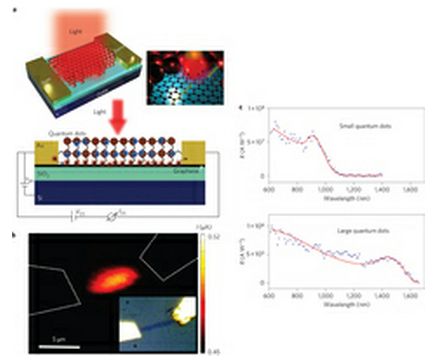Researchers Turn Graphene into Photo Detector Material
A group of researchers has discovered a way to potentially use graphene for photo detectors in future products such as digital cameras or night vision goggles.
Typically, graphene has rather terrible light-sensing capabilities as it is just 3 percent efficient. However, graphene is apparently good enough to become a photo detector material when it is covered gold electrodes, as well nano-scale crystals, commonly referred to as quantum dots. The scientists experimented with different mixes of the material and finally ended up with a detectivity of 7×10^13 Jones. It is not exactly record breaking for photo detectors overall, as the best detectors today reach more than 1x10^14 Jones at room temperature.
However, the results were still good enough to predict that graphene will also make its way into photo detectors and surface in mass market applications. The research team at the Institut de Ciencies Fotoniques in Barcelona, Spain, said it is now focusing on increasing the size of its detector to "real-world application" sizes.
Get Tom's Hardware's best news and in-depth reviews, straight to your inbox.

Douglas Perry was a freelance writer for Tom's Hardware covering semiconductors, storage technology, quantum computing, and processor power delivery. He has authored several books and is currently an editor for The Oregonian/OregonLive.
-
saturnus I must admit I've stopped reading articles about what revolutionary thing graphene can be used for.Reply
Graphene's the bees knees. We get it. Now show us some products based on it. -
Haserath Perhaps graphene is wonderful in a lab... Trying to mass produce graphene whateveryouwantittobe is a different story.Reply -
Cy-Kill memadmaxWould someone please.... please... please...Proofread this crap....Reply
I was just going to post something along these lines.
A first grader can write better than these so-called "professionals", and I use that word lightly! -
back_by_demand Is there anything that you can't use graphene for? Maybe the next generation of non-stick pans, wheels for rollerblades, who knows...Reply -
warezme If graphene still has to sit on a layer of gold electrodes and nano crystals, how is it better then existing sensors? Are they just easier to manufacture and cost less? That is what I'm thinking.Reply -
blazorthon warezmeIf graphene still has to sit on a layer of gold electrodes and nano crystals, how is it better then existing sensors? Are they just easier to manufacture and cost less? That is what I'm thinking.Reply
It might still be thinner than contemporary photo sensors, despite the gold electrodes and the nano crystals increasing it's thickness compared to a single layer of graphene. -
WyomingKnott HaserathPerhaps graphene is wonderful in a lab... Trying to mass produce graphene whateveryouwantittobe is a different story.Isn't graphene made from pencil lead using adhesive tape as the only tool? So, for a factory, you would just need big pencils and huge rolls of tape. );Reply -
blazorthon WyomingKnottIsn't graphene made from pencil lead using adhesive tape as the only tool? So, for a factory, you would just need big pencils and huge rolls of tape. );Reply
Pencil lead is graphite.
